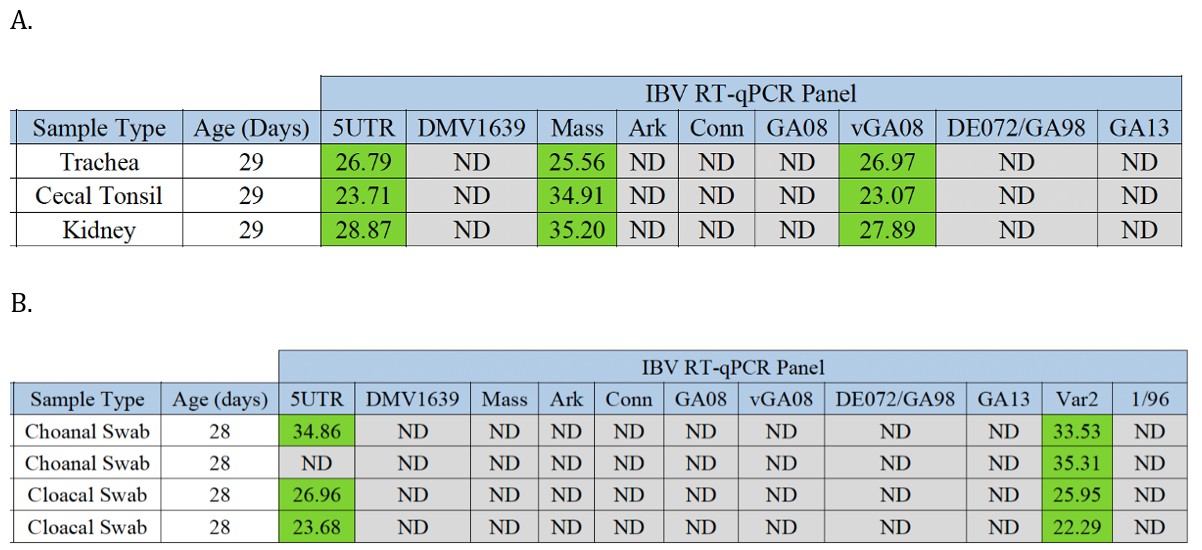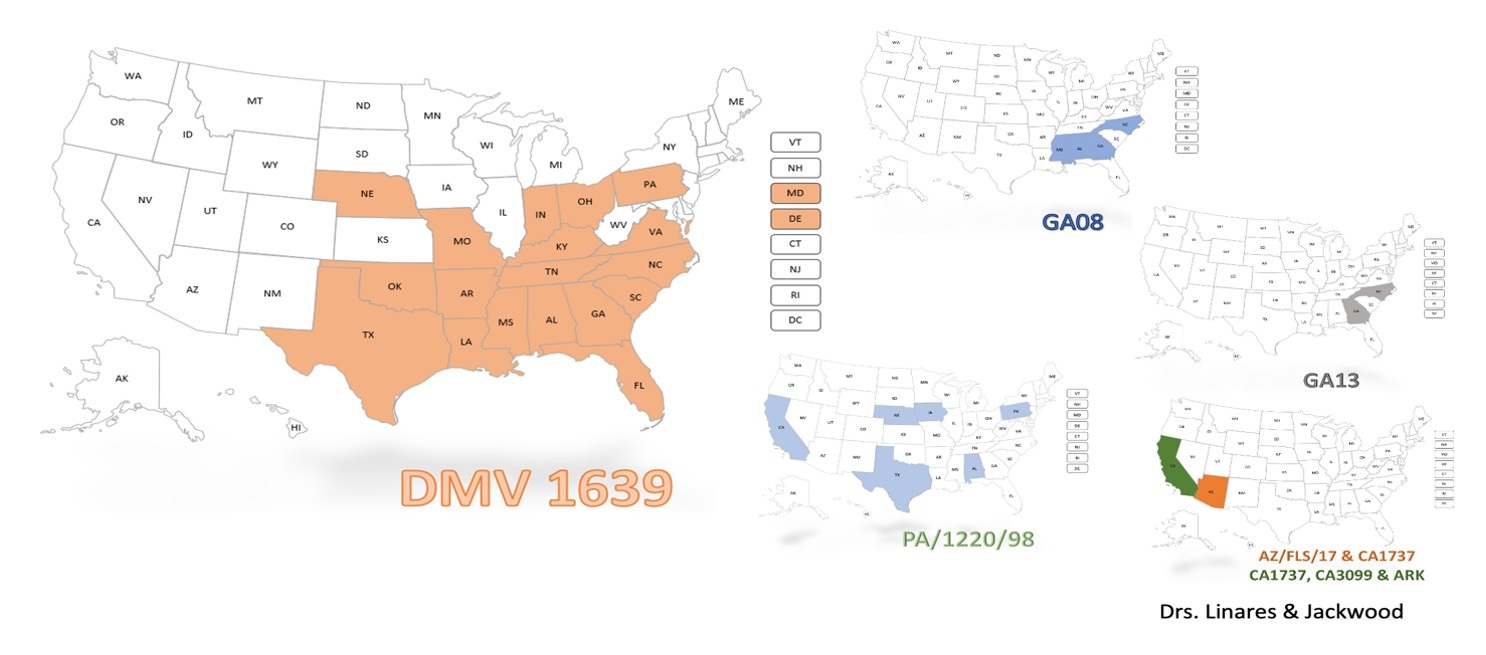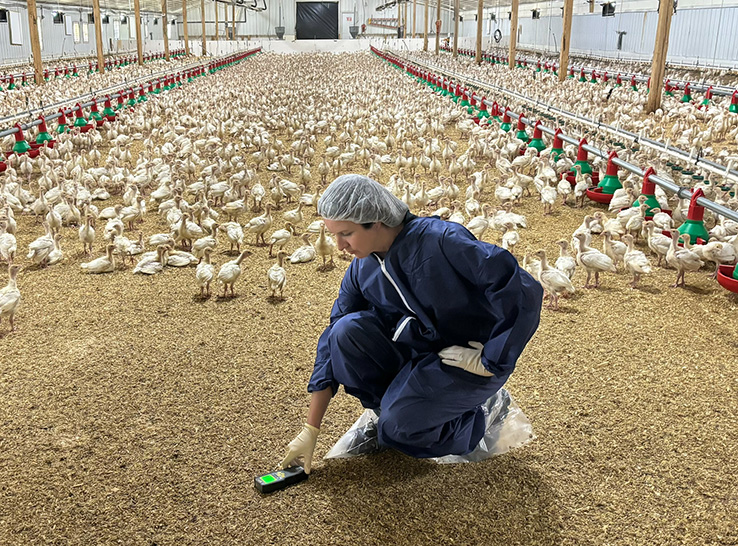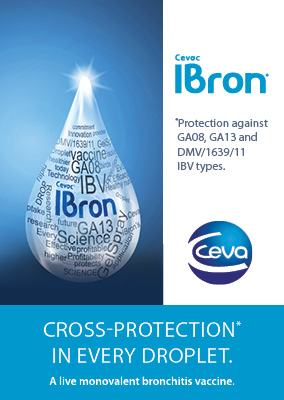By Mark W. Jackwood, PhD, and Jose Linares, DVM, Ceva Animal Health
Infectious bronchitis is an economically important disease in chickens worldwide. When the virus infects a flock, performance losses in the form of decreased feed conversion, reduced growth rate, decreased egg production and poor fertility can occur. Additional losses include carcass condemnations and reduced processing line speed in broiler operations.
When secondary pathogens or nephropathogenic strains of infectious bronchitis virus (IBV) are involved, significant mortality is possible. The virus, in combination with secondary infections, can also result in systemic disease, increasing the need for antibiotic use.
Vaccines are essential for controlling IBV. Both live attenuated and killed vaccines are used. Because the virus enters through the upper respiratory tract, live attenuated vaccines that stimulate a local immune response are most effective. However, killed vaccines play an important role in boosting circulating antibodies that can be passed to progeny as maternal antibodies. These help protect the developing reproductive tract of pullets and prevent false layer syndrome.
Moreover, due to the wide antigenic diversity of IBV, effective control typically involves vaccination with a live attenuated strain that closely matches the field virus — or a vaccine that provides cross-protection. Simultaneous administration of multiple IBV vaccine types can also help induce broader cross-protective immunity.
Controlling IBV through vaccination requires knowledge of the circulating field strains. For this reason, surveillance is critical. At Ceva’s Scientific Support and Investigation Unit (SSIU) in Lenexa, Kansas, real-time quantitative RT-PCR (qRT-PCR) panels are used to rapidly detect multiple IBV types (see Figure 1 for examples). Sequencing allows for further characterization of new variants and tracking of endemic strains’ evolution. Having accurate knowledge of circulating IBV types enables informed decisions for effective vaccination programs.
Our diagnostic data span North, Central and South America. When combined with published reports and GenBank submissions, these data provide a timely overview of IBV activity in the Americas.
Canada
In Canada, DMV/1639 (GI-17) is the most prevalent IBV type, particularly in Quebec and Ontario. Quebec has also reported limited detections of a GA13-like (GI-17) IBV type.¹ The Canadian DMV/1639 strain has evolved due to limited control measures and now shares only ~97% S1 amino acid identity with US DMV/1639 strains.
In Ontario, CA/1737 (GI-25), GA08 (GI-27) and 793B (GI-13) types have also been identified alongside DMV/1639.² In British Columbia, IBV is reported to be an issue, but no specific type data are available.³
Mass and Conn types are reported across poultry-producing provinces, and there have been two reports of Ark type (GI-9) detections — likely vaccine-related.
United States
As in Canada, DMV/1639 is the most common IBV type detected in the US. GA13, GA08, PA/1220 (GVIII) and CA/1737 are also frequently identified, with PA/1220 and CA/1737 found mostly in layers and breeders. In California, a variant of CA/1737 (CA/3099) has been detected, along with Ark type viruses, the latter often linked to vaccination.⁴ Figure 2 shows the distribution of these viruses at the state level.
Mexico
Mexico has recently reported detection of the Var2 (GI-23) IBV type, which originated in the Middle East and has since spread into China and Europe. DMV/1639 has also been identified in Mexico, and its S1 sequence shows ~99% identity with US strains, indicating a very recent introduction. GA13 and Ark types are also found in Mexico, the latter usually associated with vaccine usage.
Central America
Data are limited, but surveillance and Ceva diagnostics have detected a few types in the region. In Costa Rica, 793B and GA13-like strains have been reported.⁵ The 793B detection may reflect vaccine use. DMV/1639 has been identified in Guatemala, and while the sequence has not been determined, it is believed to be closely related to Mexican and US DMV/1639 strains. No reports are available for Nicaragua, Honduras, Belize or Panama.
South America
In Brazil, BR1 (GI-11) remains the dominant strain. Var2 has also been detected in Brazil, similar to the situation in Mexico. In Argentina, Chile and Peru, the Q1 (GI-16) type — originally from China and later found in Europe — has been reported. Peru has also seen the emergence of the TC07-2 (GVI-1) strain, which is particularly concerning due to its genetic divergence from other American strains.
Other types reported in South America include 793B, Mass and Conn, though these are likely vaccine-related.
What’s the next IBV threat to US poultry?
Mass, Conn, Ark and 793B are widely used in vaccines and are not currently considered major threats. Likewise, Q1, PA/1220, CA/1737 and GA13 have circulated without becoming dominant. However, Var2 poses a serious concern. It is transmissible, pathogenic and now established in Mexico, near the US border.
Another risk is the continued evolution of DMV/1639 in Canada. If left unchecked, this virus could further mutate into a novel antigenic variant capable of re-entering US poultry systems.
The TC07-2 strain also warrants attention. While it hasn’t yet appeared near the US border, it causes severe disease and is genetically distinct enough that US-licensed vaccines may offer limited protection. Of course, the future is uncertain, and the emergence of a completely new IBV type remains a real possibility.
Figure 1. Typical IBV panel from a diagnostic case report on samples submitted to Ceva, SSIU, Lenexa KS. A = US Case Report, B = Mexico Case Report.
Figure 2. Distribution of IBV types in the US at the state level.
References
1. Ontario Animal Health Network Poultry Quarterly Vet Report #40, 2024; Quebec Dapport du Reseau Aviaire, Dec. 2023–Feb. 2024.
2. Ojkic, D., Susta, L., Martin, E. “Genotyping of infectious bronchitis virus in Canada.” J. Vet Diagn Invest. 36:804–808, 2024.
3. Western Canadian Animal Health Network, Poultry Network Report, Jan–March 2024.
4. NCBI GenBank MW556742.1
5. Villalobo-Aguero, R., Leon, B., Zamora-Sanabria, R., Karkashian-Cordoba, J. “Molecular characterization of the S1 gene in GI-17 and GI-13 type isolates of avian infectious bronchitis (IBV) in Costa Rica from 2016 to 2019.” Virus Dis. 33:84–95, 2022.
Editor’s note: Content on Modern Poultry’s Industry Insights pages is provided and/or commissioned by our sponsors, who assume full responsibility for its accuracy and compliance.










